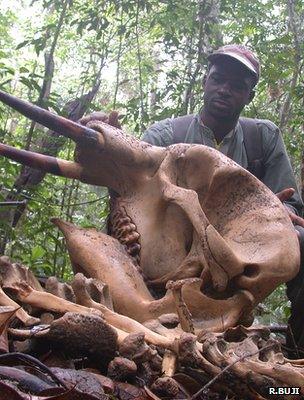Protected tropical forests' biodiversity 'declining'
- Published

Red-eyed treefrogs were among the species assessed in the study
Despite having protected status, the biodiversity in a large number of tropical forests is still continuing to decline, a study has suggested.
The authors said the findings should cause concern because the areas have been seen as a final refuge for a number of threatened species.
Habitat disruption, hunting and timber exploitation have been seen as signs of future decline, they added.
The <link> <caption>findings have been published online by the science journal Nature</caption> <url href="http://www.nature.com/nature/journal/vaop/ncurrent/full/nature11318.html" platform="highweb"/> </link> .
"The rapid disruption of tropical forests probably imperils global biodiversity more than any other contemporary phenomenon," the international team of research wrote.
"Many protected areas in the tropics are themselves vulnerable to human encroachment and other environmental stresses."
<link> <caption>Tropical forests</caption> <url href="http://www.bbc.co.uk/nature/habitats/Tropical_and_subtropical_moist_broadleaf_forests" platform="highweb"/> </link> are considered to be the biologically richest areas on the planet.
In order to assess the state of the world's protected areas, the team considered data from 60 areas, based on "262 detailed interviews, focusing on veteran field biologists and environmental scientists, who averaged more than two decades of experience".
"Our study was motivated by three broad issues: whether tropical reserves will function as 'arks' for biodiversity and natural ecosystem processes," the team wrote.
They added: "Whether observed changes are mainly concordant or idiosyncratic among different protect areas; and what are the principal predictors of reserve success or failure."
The study covered 36 nations across the tropics in <link> <caption>Africa</caption> <url href="http://www.bbc.co.uk/nature/places/Africa" platform="highweb"/> </link> , <link> <caption>Asia</caption> <url href="http://www.bbc.co.uk/nature/places/Asia" platform="highweb"/> </link> and <link> <caption>South America</caption> <url href="http://www.bbc.co.uk/nature/places/South_America" platform="highweb"/> </link> .
The findings suggested that "protecting biodiversity involved more than jut safeguarding the reserves themselves".
"In many cases, the landscapes and <link> <caption>habitats</caption> <url href="http://www.bbc.co.uk/nature/habitats" platform="highweb"/> </link> surrounding the reserves are under imminent threat," they observed.

Hunting has been identified as one of the main threats to biodiversity in protected areas
"For example, 85% of [the observed] reserves suffered declines in surrounding forest cover in the [past] 20 to 30 years, whereas only 2% gained surrounding forest."
The team reported that the data showed that forest disruption, over-exploitation of wildlife and forest resources had the greatest "direct negative impact".
They also observed that "air and water pollution, increase in human population densities and climatic change" had a weaker or more indirect impact.
The team - headed by Prof <link> <caption>William Laurance from James Cook University, Australia</caption> <url href="http://www.jcu.edu.au/mtb/staff/az/JCUPRD_054476.html" platform="highweb"/> </link> - concluded that the activities outside the protected areas had an impact on the resilience of the biodiversity within the protected areas.
"It is not enough to [protect] interiors while ignoring surrounding landscapes, which are being rapidly deforested, degraded and over-hunted," they observed.
"A failure to limit inter-related internal and external threats could predispose reserves to ecological decay, including taxonomically and functionally array in species communities and an erosion of fundamental ecosystem processes."
- Published20 June 2012
- Published13 May 2012
- Published25 April 2012
- Published16 October 2010